In the wake of the COVID-19 outbreak, a profound shift in global health consciousness has been observed. People are becoming more mindful of their health and lifestyle choices, propelling the health products and wellness sector to the forefront.
As this uprising trend brings a surge of new competitors, setting your business apart becomes crucial. One powerful strategy to differentiate your brand is through native advertising.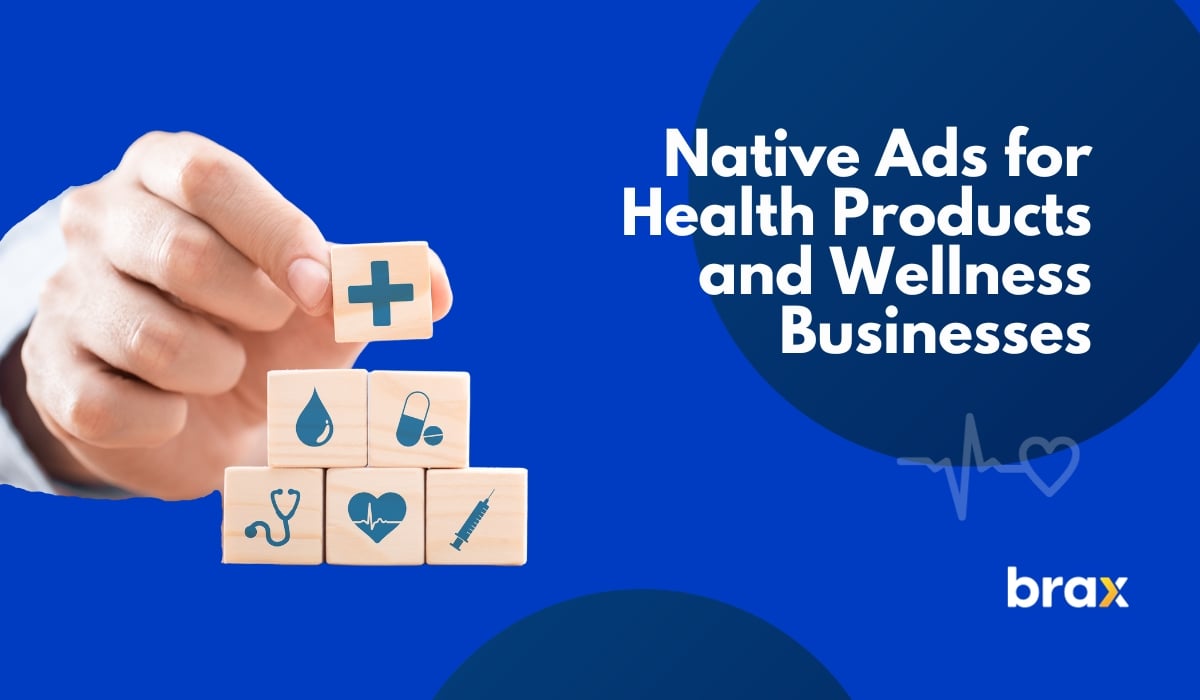
Native advertising, camouflaged in the form of useful content, doesn’t intrude on the user's experience and merges seamlessly with the platform on which it appears.
By delivering value and building trust, it carves a niche for your brand in the densely populated wellness market.
How exactly can you do that? This article will help you out, so let's get started!
Quick Introduction to Native Ads
Native ads are like chameleons of the advertising world. They blend seamlessly with the content that surrounds them on a platform.
Unlike traditional pop-up ads, which can be disruptive, native ads don't interrupt your browsing experience. Instead, they appear as part of the content you're already viewing or reading.
You might see them as an article on a blog you regularly follow, a video on your favorite streaming site, or a post in your social media feed. Their goal? To provide the reader with valuable content that matches their interests while subtly promoting a brand or product.
For health and wellness businesses like yours, native ads can share health tips, wellness guides, or product benefits, thereby positioning your brand as a trusted expert in the field.
In this article, we'll talk about a specific type of native ads — the recommendation type shown in blogs and websites.
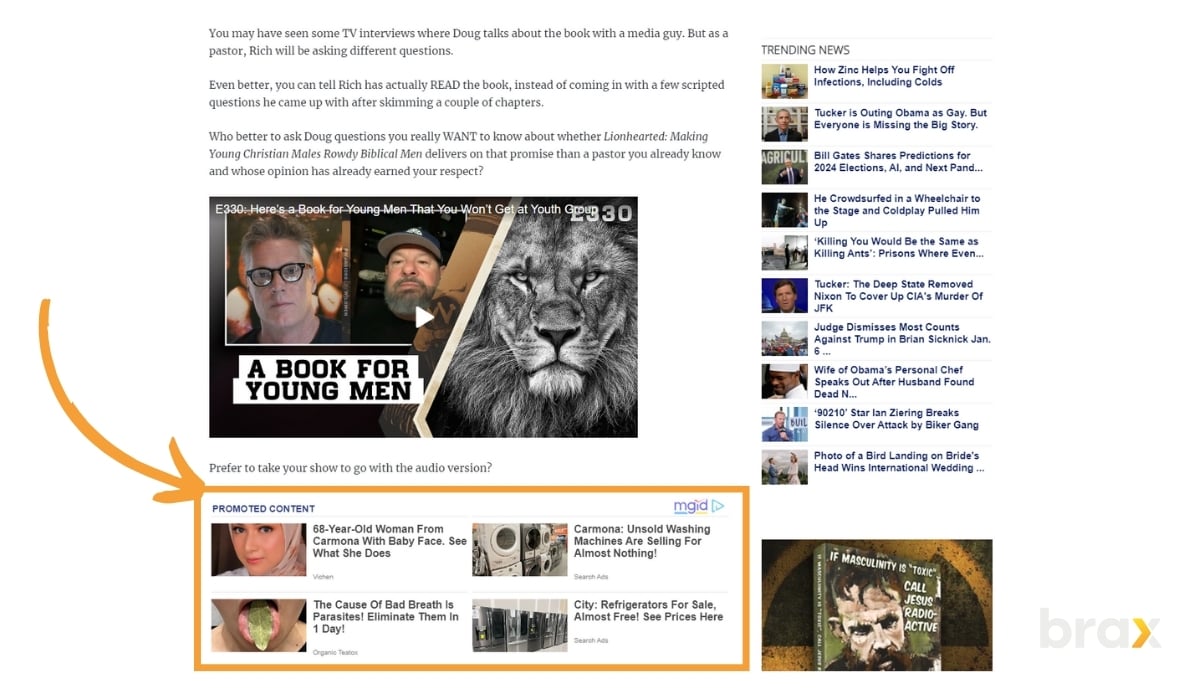
Understanding Health Products and Wellness Businesses
The wellness industry stands at the forefront of the global market in 2023.
It boasts an impressive increase, reaching $4.75 trillion in 2022, according to the Global Wellness Institute. It is even predicted to reach $8.5 trillion come 2027.
This surge in wellness sector growth is attributable to the world's increasing mindfulness of health and lifestyle choices.
Health and Wellness Sectors
The health and wellness industry encapsulates a diverse spectrum of sectors, each catering to different aspects of individual well-being. These sectors include:
- Nutritional Supplements and Vitamins: Providing essential nutrients that may not be adequately met through diet alone.
- Organic Food Markets: Offering chemical-free, naturally grown food products for a healthier diet.
- Fitness Facilities and Equipment: Gyms, yoga studios, personal training, and home fitness equipment for regular physical exercise.
- Holistic Therapy Services: Acupuncture, chiropractic, massage therapy, and other holistic health practices.
- Mental Health Services: Counseling, psychotherapy, mindfulness apps, stress management, and other mental health support systems.
- Beauty and Skincare: Natural and organic skincare and beauty products that promote skin health and anti-aging.
- Wellness Tourism: Travel aimed at promoting health and well-being through physical, psychological, or spiritual activities.
- Spa and Therapeutic Facilities: Providing services that contribute to relaxation and stress reduction.
- Weight Loss Programs and Products: Diet plans, weight loss supplements, and fitness regimes aimed at helping individuals achieve their weight goals.
- Health and Wellness Education: Online courses, workshops, and training programs to educate individuals about maintaining a balanced lifestyle.
A specific sector that has witnessed a significant rise is the health products sector. Consumers are increasingly turning towards alternative therapies and natural products, boosting the dietary supplement market.
Digital health, a newer entrant in the wellness industry that involves the use of portable devices such as smartwatches, has transformed healthcare accessibility.
It has a market value projected to reach $549.7 billion by 2028 (from $180.3 billion this year), according to Markets and Markets. Digital health apps and telehealth platforms are becoming critical tools for maintaining health.
Trends and Insights into the State of the Health and Wellness Industry
The wellness industry has evolved and continues to evolve rapidly, marked by emerging trends and insights.
Personalized
Personalization is a major trend in 2023, with consumers seeking tailored health and wellness solutions based on their individual health data. Consumers are engaging more with brands that provide personalized products or services, increasing customer loyalty and retention.
Digitized
Another trend is the melding of technology and wellness. Wearable tech, AI-powered health apps, and virtual wellness experiences are increasingly popular.
They make wellness accessible, interactive, and engaging. Grand View Research noted that the global health and wellness tech market has been valued at $61.3B globally in 2022.
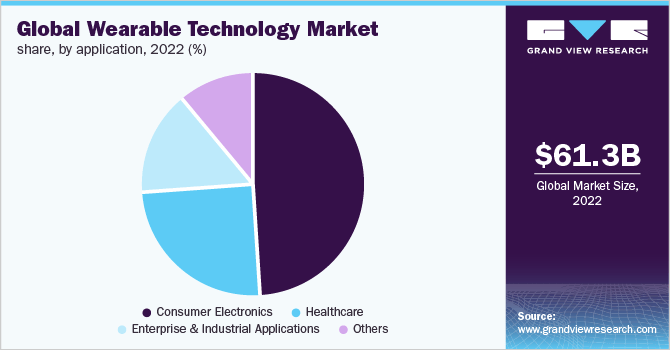
Sustainable
Sustainability is gaining momentum in the wellness industry. Brands that demonstrate a commitment to sustainable practices attract consumers who value eco-friendliness.
In fact, according to Nielsen, brands with a demonstrated commitment to sustainability grew more than twice as fast as those without.
Advantages of Using Native Ads for Health Products and Wellness Businesses
Advertising plays a pivotal role in the health and wellness industry.
It's more than just about promoting a product; it's about communicating values, building trust, and establishing a brand identity in a crowded marketplace.
Native advertising, in particular, is transforming the advertising landscape. By integrating promotion seamlessly into useful content, it does not disrupt the user experience.
Instead, it enhances it by providing valuable content that aligns with the user's interests. This strategy helps health and wellness businesses position themselves as trusted experts in the field, driving customer engagement and loyalty.
In this highly competitive market, native advertising is a potent tool for brands to differentiate themselves and connect with their target audience in a meaningful way.
Here's a list of benefits that health businesses can get from using native ads:
- Enhanced User Experience: Native ads are designed to match the look and feel of the media format they appear in. They do not disrupt the user experience but rather complement it, thereby offering a seamless and less intrusive experience for consumers.

- Better Engagement: As native ads blend in with the content on the platform, they are more likely to engage users. Consumers interact with native ads 20 to 60% more than with standard banner ads, according to the Interactive Advertising Bureau.
- Increased Brand Awareness and Recall: Native advertising can significantly boost brand recognition and recall. Since these ads are often found in content-consumption environments, they allow for a deeper level of integration and resonance with the audience.
- Improved Trust and Credibility: Native ads are typically less direct and more informational than traditional ads. This characteristic allows businesses to establish themselves as authorities in the wellness industry, thereby building trust and credibility with consumers.
- Boost in Sales and Conversions: Due to higher levels of engagement and trust, native ads can lead to higher click-through rates, which can ultimately increase sales and conversions.
- Better Targeting and Personalization: Native ads can be tailored based on specific demographics, interests, and behaviors, allowing businesses to reach the right audience with the right message at the right time.
- Optimized for Mobile: More people consume content on mobile devices nowadays. Native ads are ideal for a mobile-first approach since they adapt to the environment in which they are placed, providing an optimal viewing experience.
- Increased ROI: With all these benefits, native advertising often generates higher returns on investment (ROI) compared to other forms of advertising. They provide both immediate and long-term benefits, from immediate click-throughs to longer-term brand recognition and loyalty.
Remember, native advertising is not just a trend but an effective strategy that health and wellness businesses can leverage to reach and engage their target audience in a meaningful and beneficial way.
How to Create Effective Native Ads for Health Products and Wellness Businesses
Seeing that native advertising is a good option for advertising health products, let's talk about how you can do utilize it properly.
To maximize the efficacy of your native advertising campaigns in the health and wellness sector, consider the following strategic tips:
#1. Understand Your Target Audience
To effectively reach your target audience with native ads for health and wellness offerings, you must actively engage in understanding their unique characteristics.
Start by identifying their preferences — what wellness products do they already use and prefer? What type of health content do they consume and share?
Next, delve into their behaviors. When and where do they typically engage with health and wellness content? Are there any patterns in their purchasing behaviors?
Understanding their needs and concerns is also crucial. What health challenges are they facing? What wellness goals do they aspire to achieve? What are their fears and anxieties related to health and wellness?
Gathering this information not only helps in crafting a message that resonates with them but also ensures your ad is relevant and addresses their specific needs.
Proper ad targeting hinges on having a detailed understanding of your audience. Therefore, use this insight to shape your ad targeting strategy. By doing so, you can ensure your ads reach the right people at the right time, ultimately leading to higher engagement and conversions.

#2. Choose the Right Platform
Your choice of platform should align with where your target audience is most active. You need to know where your audiences are hanging out digitally.
Whether it's online publications or mobile apps, you need to ensure that your ad is placed in an environment where it can reach your target demographic.
Different audiences go to different websites. For instance, older and financially capable audiences frequently visit Forbes.com. Millennials love visiting Vice.com, though.
If you know the advertising platform that works with the publishing websites your audience frequents, then you can choose them for your advertising needs. Visit our article on the full list of native advertising networks and some of their top publishers.
Aside from that, the right platform would have the targeting settings you need to effectively narrow down to your perfect audience. Some native advertising networks can even target based on audience interest or website content category.
#3. Design the Ad to Blend In
To maximize the effectiveness of your native advertising, design your ad to seamlessly blend with the platform's existing content.
Remember, a key attribute of native advertising is its ability to mimic the look and feel of the environment it's placed in.
While native ads inherently handle the visual aspect, you must ensure the ad content matches the platform's tone, style, and format.
To accomplish this, familiarize yourself with the platform's content and understand its unique style. Does it use a professional, casual, or humorous tone? Is the content typically long-form articles, infographics, or video content? What kind of headlines and body text are used?
Once you've grasped these elements, incorporate them into your ad. By mirroring the platform's tone and style, your native ad will feel more like a natural component of the content, thereby increasing user engagement and trust.
#4. Craft a Compelling Message
Crafting a compelling message for your native ad is crucial to engage your target audience effectively. The aim is to capture their interest, resonate with their needs, and provide them with valuable information.
Start by focusing on the benefits of your health product or wellness service rather than merely describing its features.
Show your audience how your offering can solve their problems or improve their well-being.
Identify the key concerns or aspirations of your target audience related to health and wellness. Tailor your message to address these points directly, showcasing how your products or services can help them reach their wellness goals or overcome their health challenges. This approach will make your ad more relevant and engaging.
One thing we've seen works really well is telling your audience how their pain point can be solved in a simple manner. Of course, don't be clickbait! Make sure you can back up your claim and that you can provide concrete information.
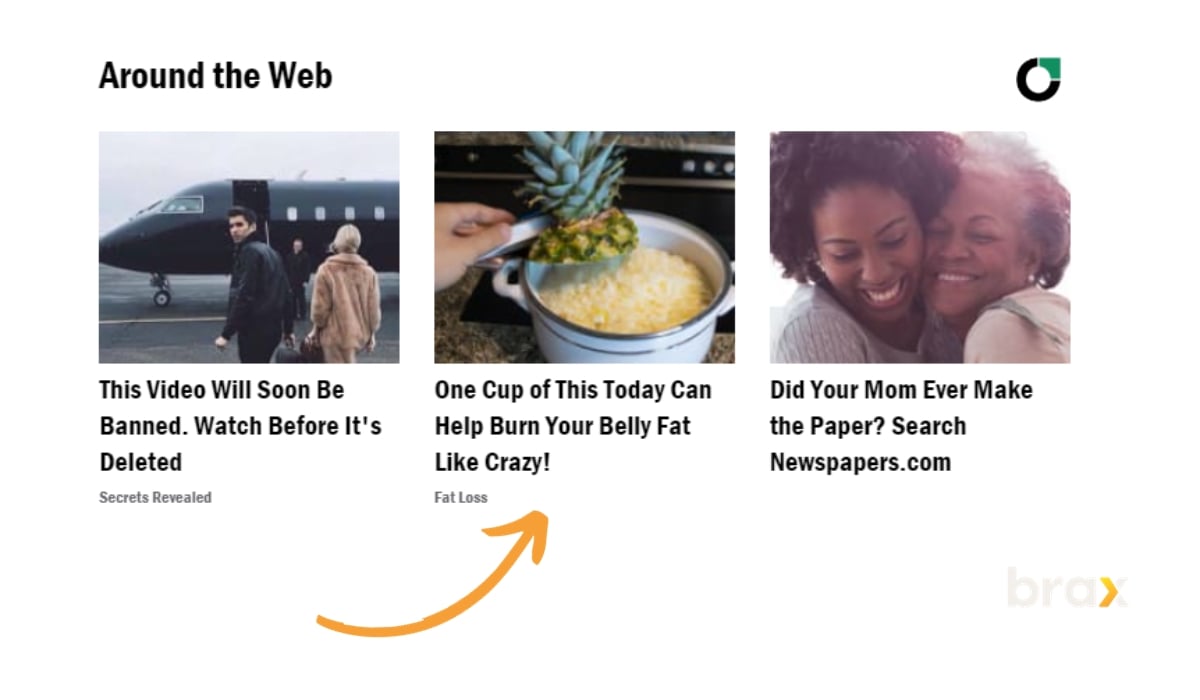
#5. Test Multiple Images
Incorporating high-quality, health-related images in your native ads is a powerful strategy to captivate your audience's attention. Select images that not only look good but also align with your brand, message, and the needs or aspirations of your target audience.
Keep in mind that the image should connect emotionally with your audience, evoke their interest and curiosity, and encourage them to engage with your ad.
Images that depict healthy lifestyles, wellness practices, or the positive outcomes of using your health products can be particularly effective.
For diet, wellness, and exercise-related ads, smiling people in action work best.
Another image type we've found effective is those that seem to be taken by ordinary people using their smartphones.
You can use vibrant, fresh ingredients in natural settings and as if taken for the purpose of sharing on social media. For instance, a close-up shot of a salad bowl full of colorful, fresh vegetables, with a bottle of vitamins or health supplement subtly placed at the side.
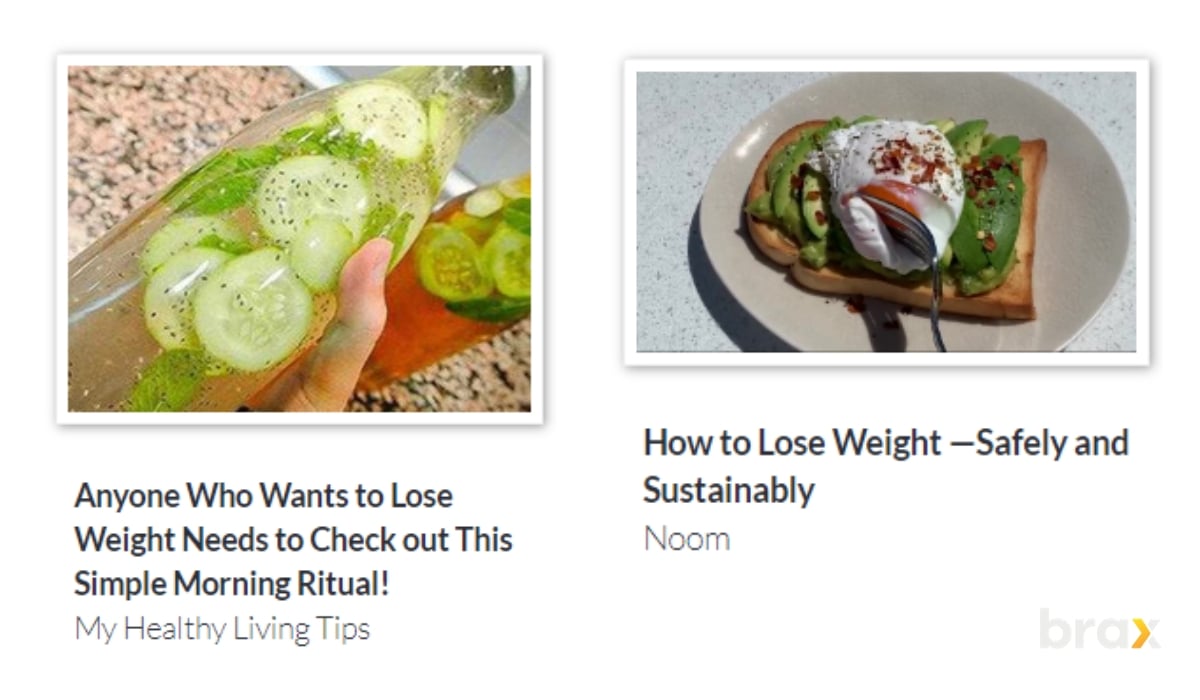
If you can add an image of a person enjoying the product you are depicting, even better! In the same vein, images of the actual health issue or people showing signs of the health concern can also prove effective. It all depends on the product, audience, or publishing website.
It would be best to test multiple images against an ad text, like the ad campaign below.
If you would notice, the ad title is the same, but the images are different. Choose the best image and ad text combination once you are done with your test.
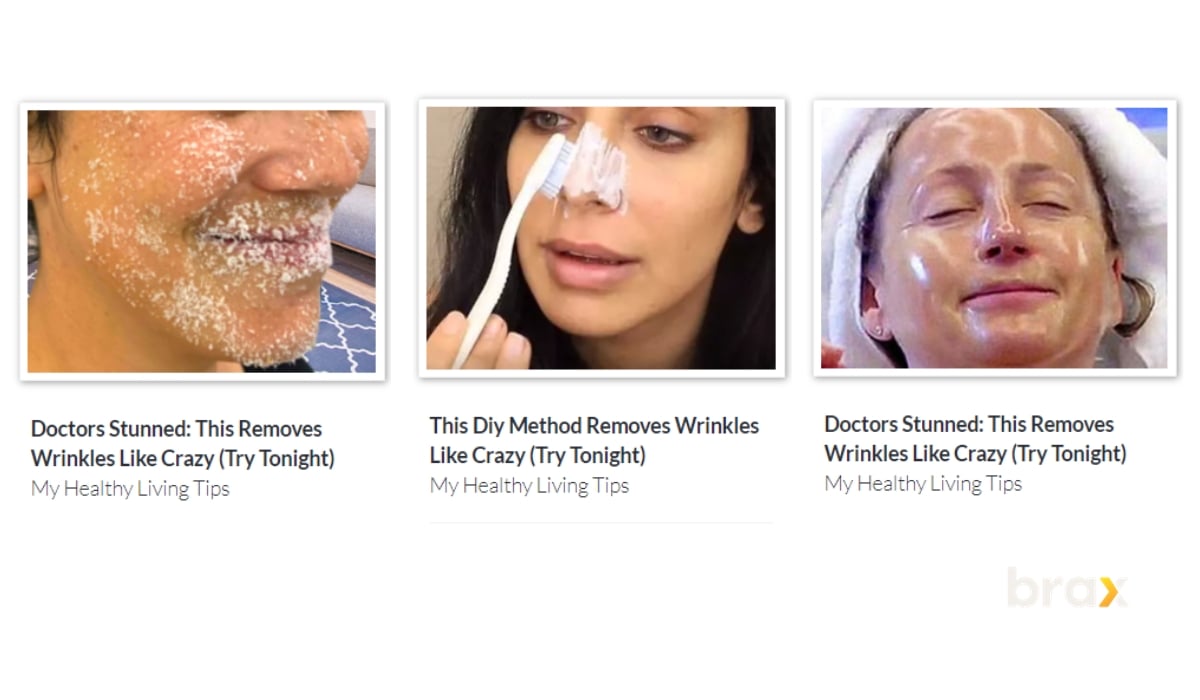
Remember, a well-chosen image can speak volumes about your health product or wellness business, potentially generating more interest and engagement than text alone.
#6. Personalize Your Ad
Personalization is a powerful tool that can propel your native ads from being generally appealing to specifically resonating with each individual in your target audience.
Use user demographics, browsing history, or personal preferences to tailor your message and make your ad more relevant.
Start by creating a separate campaign for each set of ads aimed at a specific target group.
If you are targeting males who are of a certain age and you actually set these under the targeting settings of your native ads campaign, then you can also mention this information in the ad text.
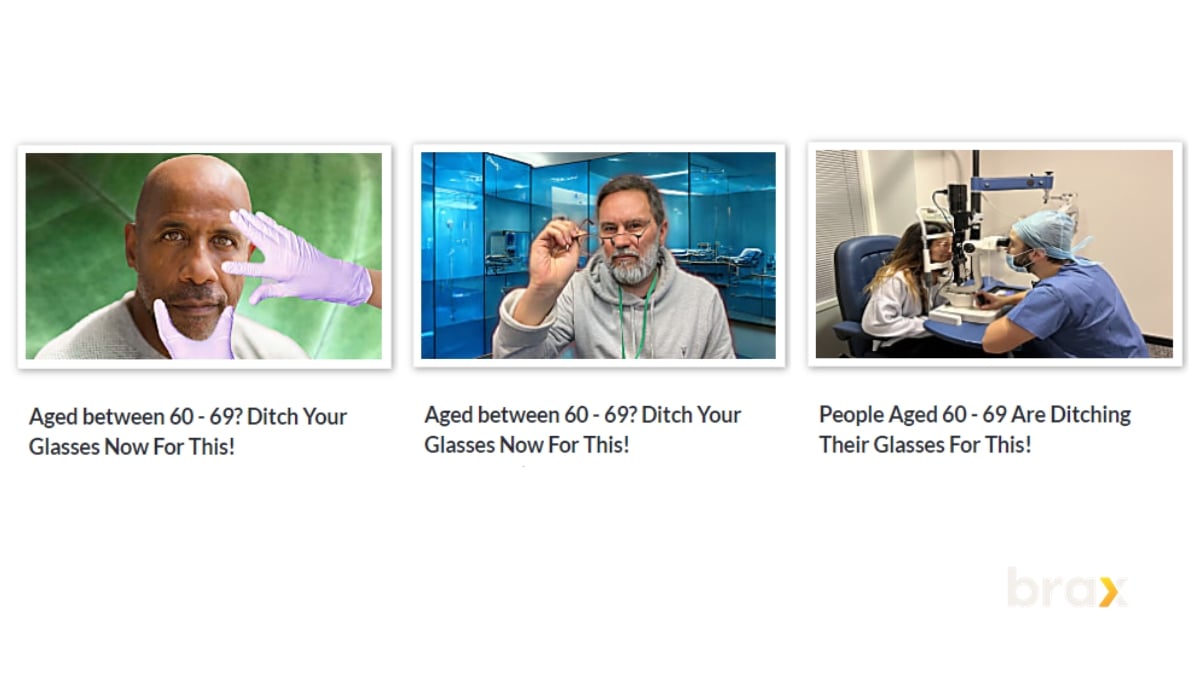
You can also harness the prowess of dynamic keywords to enhance personalization within the ad text. These dynamic keywords can range from city, country, device type, and brand, to IP, ISP, and more.
The availability of these macros is dependent on the native advertising network you're using. By incorporating dynamic keywords, you ensure that your ad speaks directly to the individual, fostering a connection that could lead to higher engagement and conversion rates.
Remember, in a world where consumers are bombarded with generic advertising messages, a personalized ad stands out, making your health product or wellness business more appealing to potential customers.
#7. Provide Worthwhile Information About Health
Enhance the credibility and appeal of your native ads by providing accurate, valuable information about health and wellness. Remember, your audience comes from content sites seeking to satiate their curiosity and gain knowledge.
Present your health product or wellness business as a solution, but only after you have engaged the audience with useful and informative content.
Start by identifying common health issues or wellness goals that resonate with your target audience.
Then, offer actionable advice, backed by scientific research or expert opinion, to address these points. In this way, you present your brand as a knowledgeable and trustworthy source of information.
For example, if your product is a fitness supplement, you could first discuss the importance of regular exercise and a balanced diet. You can also provide quick tips on how you can make lose weight easier. Then, introduce your product as a supplemental aid that can help enhance their fitness journey.
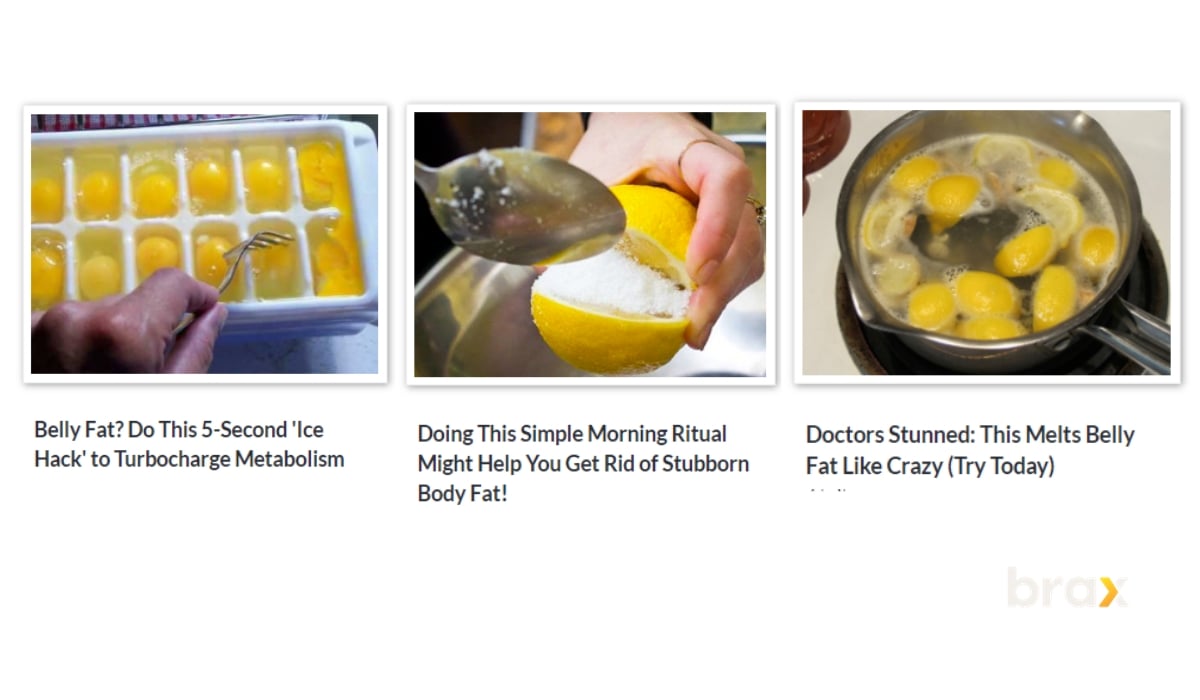
Or, if you offer a wellness service like yoga classes, share insights on the benefits of practicing yoga regularly. Subsequently, emphasize how your classes provide the guidance and convenience they need to embark on their wellness journey.
The key here is balance.
You want to offer genuine value to your audience, engaging them with informative and interesting content, but you also want to subtly introduce your product or service as a potential solution to their needs.
This approach not only feeds the curiosity of the reader but also establishes your brand as a thought leader in the health and wellness space. Plus, it seamlessly blends your ad into the content environment, fostering a more positive audience response.
#8. Match the Landing Page with the Ad
When creating native ads for your health products or wellness services, you should ensure consistency between your ad and its corresponding landing page. This means that the tone, style, messaging, and visuals of the ad should align with that of the landing page.
Consistency enhances the user experience, strengthens your brand image, and increases the potential for conversions.
Start by echoing the key messaging from your ad on your landing page.
If your ad promotes a fitness product that helps users lose weight, the landing page should reinforce this message, providing more detailed information about how the product works and the benefits it offers.
Include compelling evidence to back up your claims, such as case studies, testimonials, or scientific research.
Next, maintain visual consistency.
The image you used on your ad should be reflected on your landing page. If you split-test images, make sure the image you use are still within the landing page. This visual alignment reassures users they are in the right place and helps reinforce your brand identity.
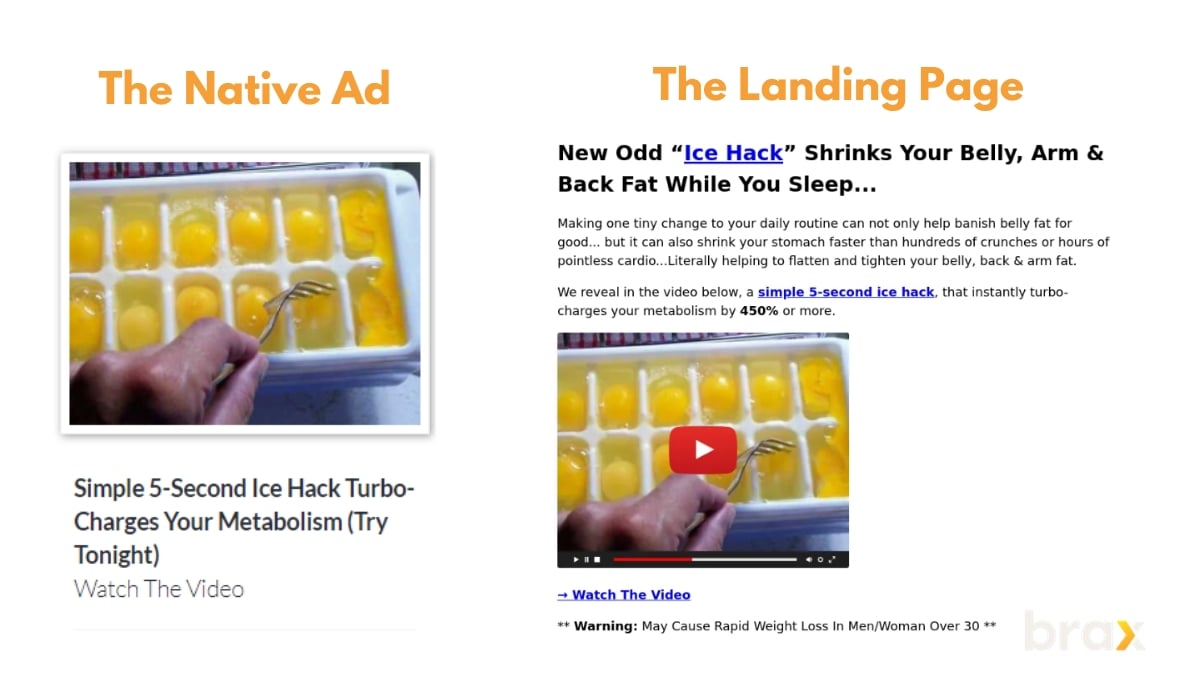
Additionally, ensure that the user journey from the ad to the landing page is smooth and seamless. Avoid any abrupt changes in content, style, or tone that could confuse or deter users.
If your ad promises a solution to a health problem, the landing page must meet this expectation by providing relevant and clear information.
Lastly, your landing page should deliver on any promises made in the ad. If your ad offers a free trial, discount, or special offer, make sure this is clearly and immediately available on the landing page.
Any discrepancy between your ad and landing page can damage your credibility and reduce trust in your brand.
#9. Include a Clear Call-to-Action
Including a clear and compelling Call-to-Action (CTA) in your landing page is crucial for guiding your audience on their next steps.
A well-crafted CTA can motivate your target viewers to engage further with your health product or wellness business. It serves as a directive that entices audiences to visit your website, download a guide, or make a purchase.
Your CTA should be concise and clear, leaving no room for ambiguity about what action the audience needs to take.
Use action words that inspire immediate responses, such as 'Buy Now,' 'Download Today,' or 'Start Your Free Trial.' These phrases create a sense of urgency and encourage viewers to act promptly.
Moreover, your CTA should align with your ad's primary objective. If your goal is to drive traffic to your website, your CTA might be 'Learn More.'
If you aim to boost product sales, 'Shop Now' could be your CTA. Always ensure that the action you're urging aligns with your overall advertising goals.
Incorporate your CTA seamlessly within your ad content. Don't just tack it on at the end; make it an integral part of your messaging. This approach will make the transition from viewing the ad to taking action feel natural and intuitive for your audience.
Finally, personalize your CTA based on your audience's needs or preferences. A personalized CTA can significantly increase engagement and conversion rates, as it resonates more deeply with individual viewers.
For example, if your health product addresses weight loss, a CTA like 'Start Your Weight Loss Journey Today' could be very effective.
#10. Monitor and Adjust Your Ad
Regularly monitoring your native ad's performance is an instrumental aspect of successful advertising.
Start by tracking key metrics like click-through rates, engagement rates, and conversion rates. These metrics provide valuable insights, allowing you to gauge the effectiveness of your native ad. Should you find that certain aspects of your ad aren't resonating with your target audience, be prepared to adjust your strategy.
For instance, if your click-through rates are low, you might want to consider revising your ad's headline or image. If your conversion rates aren't up to par, it could signal an issue with your landing page or the alignment between your ad and its corresponding landing page.
Remember, the goal is to create a seamless journey for your audience, from the initial ad click to the conversion.
Beneficial tools like Brax can further enhance your native ad strategy for your health product or wellness business.
Brax offers a centralized platform where you can create, monitor, and manage your native ad campaigns across multiple advertising networks. It provides real-time data and performance trends, enabling you to swiftly identify and address any issues.
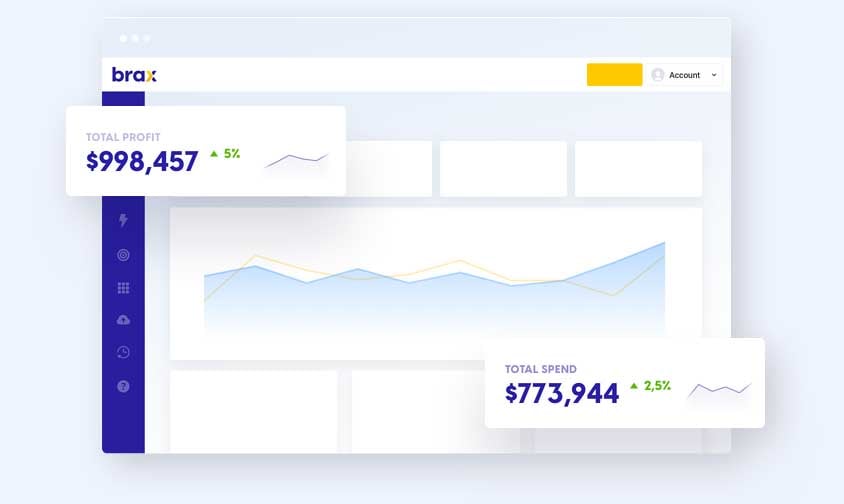
By using Brax, you can ensure that your native ads stay optimized, relevant, and impactful. Remember, the world of digital advertising is dynamic and ever-changing. Therefore, it's vital to stay adaptable, adjusting your strategy based on the latest trends, audience preferences, and performance data.
Interested in elevating your native ad strategy? Book a free demo with us today and witness firsthand how Brax can revolutionize your advertising campaigns.
Remember, the goal is to provide value to your audience while subtly promoting your health and wellness products. By following these steps, you can create native ads that not only drive engagement and conversions but also enhance the user experience.
The Future of Native Ads in the Health and Wellness Industry
As we venture into 2024 and beyond, the health and wellness industry can anticipate a continued surge in the impact of native advertising.
Predictions indicate an increased integration of Artificial Intelligence (AI) and machine learning, enabling more personalized and contextually relevant native ads.
Furthermore, the rise of voice search and smart devices will likely usher in a new era for native ads, where they seamlessly blend into our everyday conversations and routines.
Recognizing these trends, health and wellness businesses can no longer afford to overlook the power of native advertising. It is an effective tool that not only boosts visibility and conversions but also enriches the user experience.
Now is the perfect time to integrate native ads into your marketing strategy and future-proof your business.
To ensure your native ads are optimized and impactful, consider leveraging a platform like Brax. Get started with a free trial, and witness firsthand the transformative power of well-crafted and well-managed native ads.

